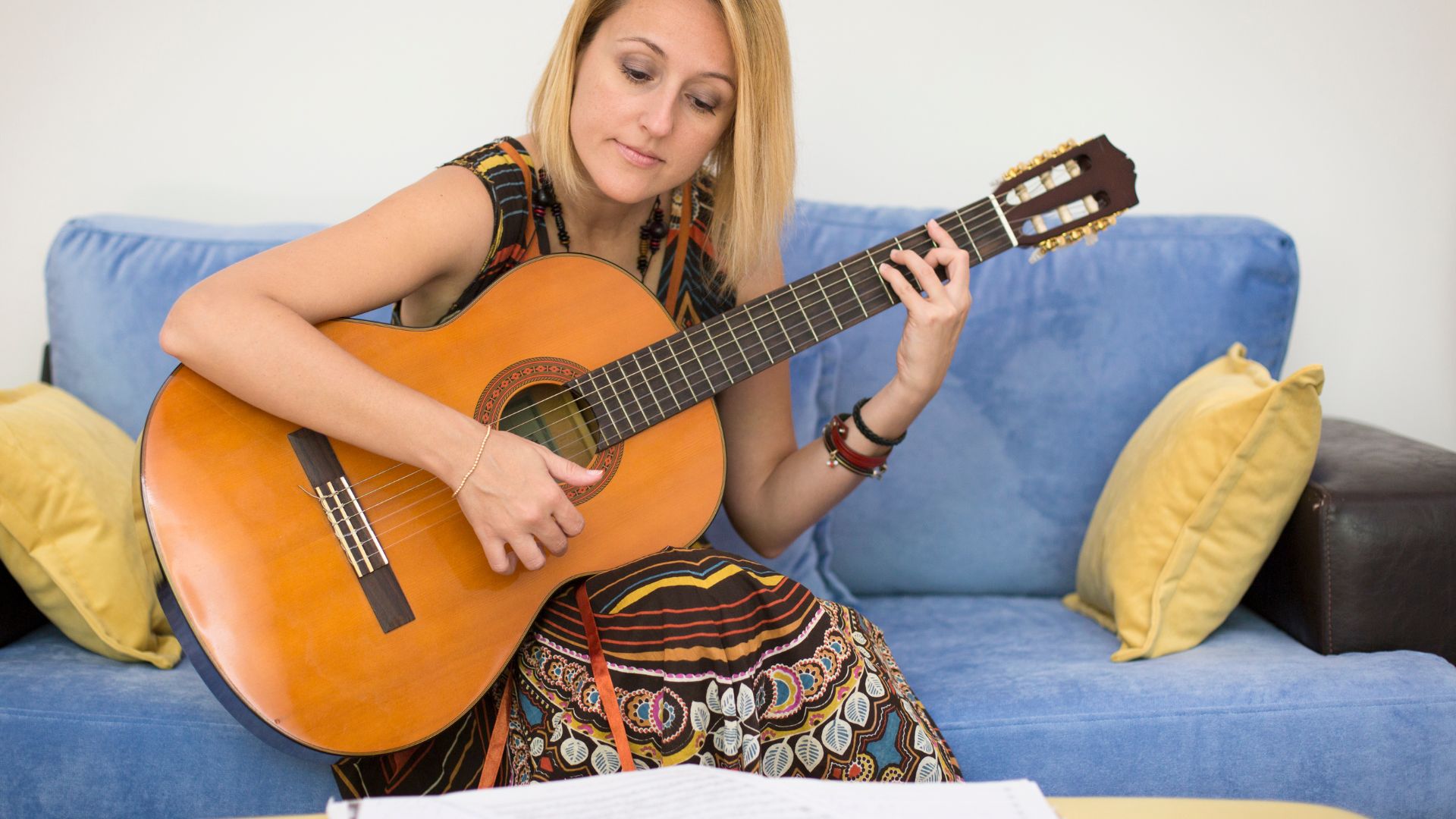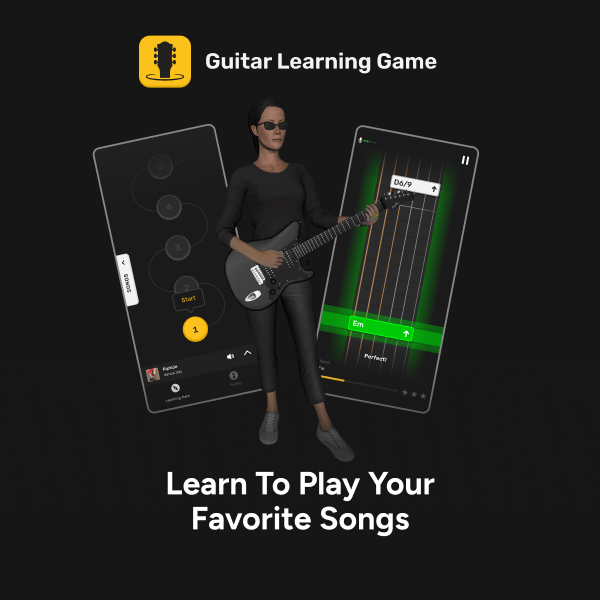What Can You Do to Practice Playing Guitar Without a Guitar?
There are moments in every guitarist’s life when playing the guitar is just not an option. You may be traveling, or you could be injured or undergoing treatment. However, you may want to practice playing guitar no matter what and it is quietly normal.
There are two components to learning to play the guitar. The physical one entails improving technique, learning new chords and scales, melodies, and so on. We tend to focus on the physical component the most, especially when training.
There is also the psychological and emotional part to consider. The mental aspect is comprehending what you’re doing and how everything fits together. This is related to the emotional side, which helps you make solid judgments on what seems nice and all the nuances around it. And the most significant potential exists in this mental/emotional element when you cannot play your guitar.
This article will show you how to practice playing guitar while on vacation, traveling, commuting, or anytime you have free time. You do not need to bring a guitar to practice these sections. So, let’s look at ways to strengthen your psychological aspect when you can’t play guitar.
Practice Playing Guitar | Watching Videos
Instead of viewing a viral YouTube video that will most likely not enhance your life, watch a video of a fantastic guitarist who will motivate you to practice harder. It’s incredible how a five-minute film can completely change your outlook and inspire you to discover new things.
When you focus just on the concepts rather than playing them, you may often make more significant progress in theory. You can watch as many times as you need until everything makes sense. You’ll be astonished at how far you can get without the instrument.
Ear Training Can Help You Improve Your Hearing
Your ear talents are essential to work on without a guitar. What distinguishes decent guitarists from great ones is ear training. Guitar practice isn’t simply about what our hands perform; our ears also play a significant part. You cannot stress the importance of honing your ear as a guitarist.
Ear training allows many guitarists to master songs just by listening to them. You’ve seen what a well-developed ear can do if you’ve ever witnessed a guitarist jump into a jam and quickly play in the perfect key or play a tune after listening to it once.
Recognizing notes, scales, and chords by hearing or precisely identifying rhythms may appear complicated at first, but with the proper instruction, you can do it too. Ear training is a vital part of becoming a skilled guitarist. While there are ways to practice hearing training with a guitar in your hands, you may also do ear training without one.
There are several methods for practicing ear training. My recommendation is to utilize an ear training app. Ear training applications allow you to practice whenever and anywhere you choose. You don’t need a guitar, and you can practice in public with headphones or earphones without receiving strange glances.
The weird thing about ear training is that it becomes second nature after a certain amount of regular repetition. What seemed unattainable when you first began becomes plain and simple. I strongly advise you to incorporate ear training into your practicing regimen. Because you don’t need a guitar to practice ear training, it’s an excellent way to improve your musical ability.
Practice Playing Guitar | Get Fretboard Knowledge
Swiftly recognizing what notes you’re playing or fast locating notes is an essential step in becoming an experienced guitarist. It takes some time to memorize the notes on the fretboard, but it is well worth the effort. If you haven’t already learned the notes on the fretboard and can find any note quickly, you may start practicing without a guitar.
You would think it’s impossible to accomplish without the guitar, yet it is! You write it down! The goal is to form a mental picture of where all of the notes are.
Popular guitar teachers took long train rides and took the opportunity to write notes on a fretboard on paper. Start with one note and write it all over the paper fretboard before moving on to the following note.
After you’ve done it once, you may try using a different way of designing a guitar neck. You may just draw six lines and call it a fretboard, or you can use a sheet with a simple graphic or a guitar fretboard. You’ll gradually link all the dots on the guitar fretboard, and everything will be evident in your mind.
Memorize Scales and Chords
When practicing chords or scales, having a guitar handy is essential, but you may also work on your chord and scale knowledge without a guitar.
Memorizing chord forms before picking up a guitar makes practicing certain chords simpler. You’ll learn the chords faster if you know precisely which frets to play before grabbing the guitar.
There are several methods for memorizing chords and scales that do not require the use of a guitar:
Guitar Apps: As you might expect, several applications are available to assist you with memorizing chords and scales. Some applications are meant to function as a library, allowing you to quickly seek up different chords or scales. Simply go through each chord and picture placing your fingers on the guitar in the chord formation to practice them.
Guitar Flashcards: The concept is to glance at the chord name on the front of the card (there is nothing on the back), then try to remember all you know about the chord. Then you look at the entire card to see what you got correct and incorrect.
If you answered all the questions correctly, you would place that card in the ‘correct’ pile. If you get one or more details incorrectly, you put the card in the ‘wrong’ pile.
Then you go through each card until you’ve finished the pack. The ‘incorrect’ pile is shuffled, and you go through them again. Eventually, you’ll be able to remember every nuance of every chord on the first try.
Practice Playing Guitar | Active Listening
We use passive listening almost all the time when listening to music. You may believe you are fully immersed in the song, but there is a notable change between listening to and consciously listening to music.
Active listening is a vital ability to master if you want to become a good musician. It is incredibly different from how we generally listen to music.
You’ll discover details in guitar sections you didn’t notice once you learn how to listen actively to a song. You can see links between different instrument components that will help you improve your playing. You’ll also have a deeper understanding of the music.
Make no mistake: attentive listening requires excellent concentration and effort. Music cannot be actively listened to while doing anything else, such as playing a video game or surfing social media. To actively listen to music, you must be able to give it your undivided attention.
Active listening aims to focus your full attention on a specific section of music. You might concentrate on the tone of a guitar part, the methods you hear, the rhythm, or any other aspect.
You must zero in on a particular aspect and maintain complete concentration on that element throughout the song. And even pause and replay sections of the music to ensure that you thoroughly understand what you’re hearing.
If you want to perfect a song on guitar, I strongly advise you to actively listen to it. Listen to the music daily since you will notice more details the more you listen to it.
Study Music Theory
Music theory is a versatile collection of skills that may help you push your playing in new ways. Many guitarists are scared by music theory, and some wrongly believe it interferes with their playing.
The truth is that knowing music theory just expands your possibilities. You can follow the ‘rules’ of music theory or reject them when you like. A guitarist who understands music theory thoroughly has more alternatives than a guitarist who does not.
There are a few alternative ways to practice music theory without using a guitar. Let’s try a couple of alternative approaches.
Music Theory Books: Several books address all areas of music theory. Some books cover the fundamentals, while others cover more complex issues.
The best book for you relies on your present knowledge of music theory and what you wish to study. Reading a music theory book can help you improve your grasp of what you’re playing when you pick up a guitar.
Music Theory Apps: Some music theory applications function as introductory courses or interactive books.
One significant advantage of utilizing one of these applications is that they frequently include audio samples. Hearing audio samples allows you to better comprehend the topics.
Another advantage of utilizing a music theory app is that you don’t have to have a book. However, I prefer it over an app if you don’t mind carrying a book.
Online Resources: There are several online publications and videos about music theory. The advantage of using internet resources is that you may access numerous materials on practically any topic. If you want to learn more about modes, a quick YouTube search can yield innumerable lessons explaining methods.
Practice Playing Guitar | Writing Music
Another suggestion for what you can do to practice playing guitar without a guitar may seem unusual, but it may significantly impact your grasp of the instrument.
It may appear weird, if not impossible, to compose music without a guitar at first. However, I can tell you from personal experience that it may significantly influence your ability to compose music.
While knowing music theory can help you compose music without a guitar, you can practice this without any knowledge of music theory. The majority of what you write in the beginning will be incorrect. But, just like me, you’ll rapidly discover what sounds nice and what doesn’t.
I strongly advise spending time each week attempting to produce brief riffs, licks, and chord progressions without using a guitar. Consider how those pieces might sound and how you would play them.
Then take out your guitar and perform those sections. Do the pieces sound like what you imagined? If not, make modifications to correspond with what you hear in your brain.
If you keep practicing, it will become second nature, and your ability to compose music without a guitar will appear magical.
Conclusion
If you put all of the above suggestions into practice, you’ll gain talents that many guitarists overlook. They will help you improve your skills and talents as a guitarist in different ways. While some may be difficult initially, they all grow simpler with practice.
If you want to maximize the most of your practice sessions when you have a guitar, I strongly advise setting up a proper practice location. The environment in which you practice significantly impacts your practice’s quality; therefore, it’s essential to get it correctly.
Even if you don’t have a guitar, you can still make tremendous strides. The tips above are wonderful, even if you have a guitar that you can quickly grab anytime. These exercises can help you improve your guitar skills and boost your confidence. As usual, be patient, go slowly, and have fun!



